A Strong Beginning, In Spite of War: 1911-1920
Since 1885, the Kappa Sigma Fraternity has published a periodic magazine, first called The Kappa Sigma Quarterly and since 1891, The Caduceus of Kappa Sigma. A feature of the magazine, from the very first issue, was “Chapter Letters”—brief descriptions of the chapters’ recent activities, submitted by most, if not all, chapters for most issues. It is thus fortunate that we have access to all of the chapter letters published for Gamma-Xi Chapter from the year of its installation until the fall of 1970, when they were discontinued by The Caduceus, as a source for learning what was going on at Gamma-Xi during its first sixty years.
The March 1911 issue of The Caduceus featured the installation story of the establishment of Gamma-Xi Chapter, and the chapter’s first chapter letter appeared in that issue. In part, it read:
March 1, 1911—It is with a great deal of fear and hesitancy that the baby chapter ventures to send in a chapter letter to The Caduceus. We are gradually recovering from the excitement of entering the portals of Kappa Sigma, and are beginning to appreciate the possibilities of life within the City of Letters. We have received congratulations from all the fraternity and sorority chapters in Denison, and have been flooded with congratulatory telegrams and letters from Kappa Sigma chapters all over the country. We are represented in basketball by Bro. Lester Black, who is maintaining his reputation as best individual player in Ohio.
An editorial in the same issue of The Caduceus welcomed Gamma-Xi, noting that the Fraternity had been rather conservative in recent years about expansion. “A great many more petitions are denied these days than are granted or even encouraged. But the petitioners at Denison University were not of the sort to be passed up lightly. We feel assured that Gamma-Xi chapter is a very fine body of young men, and it is for this reason they were granted a charter from Kappa Sigma.”
The second chapter letter, dated March 28, 1911, reported that the chapter had recently initiated three additional alumni members of Beta Alpha Delta. The initial officers, including four seniors, who were installed on February 16, served only a few weeks, and at a late March chapter meeting, new officers were elected to serve for the next year, headed by Stewart W. McClelland ’12 as Grand Master.
On March 4, at the indoor track meet with Ohio University, Alfred S. Orcutt ’11, the team captain, won first place in both the one and two-mile events, breaking the local record in the latter. Joseph H. Boutwell ’12 won the 220-yard dash, also breaking the record.
The chapter letter dated April 29, 1911, introduced Gamma-Xi’s first Kappa Sigma pledge, Harold E. Dunlap ’13, who was one of Denison’s best track men and a member of the 1910 football squad. On June 1, Dunlap became the first initiate of Gamma-Xi who had not been a member of Beta Alpha Delta.

Kappa Sigma was represented on the baseball and track teams by brothers such as Lester J. Black ʼ14, Robert M. Ashley ʼ13, and Wilfred C. Coe ʼ11.
The final chapter letter of the school year, dated June 1, reported that seven of the brothers had won their “D” in spring athletics that year—Coe, Dunlap, Fred C. Parks ʼ11, Boutwell and H. Cady Reynolds ʼ17 on the track team and Black and Ashley in baseball. Six seniors graduated, and the rest of the chapter members intended to return in the fall.
The 1911-1912 school year commenced that fall with all but three of those expected returning, according to the September 30 chapter letter, which stated, “Gamma-Xi has pledged six of the best men in the university.” The chapter was represented on the varsity football team by Ashley, Dunlap, Clifton F. Schropp ʼ14, and then-pledge Harry N. Phelps ’14.
The fall initiation of eight pledges was followed by a serenade at Shepardson College for Women in the village (which did not officially merge with Denison University until 1927) and a banquet at the chapter house that lasted well into the early morning. With eleven more Beta Alpha Delta alumni having been initiated during the year, total number of initiates for 1911 reached 56.
Warren D. Miller ʼ12 was elected the university cheerleader by the student body, and the varsity football team did well that fall, completing the season with five victories, two ties, and two defeats. The chapter letter noted that there are no fraternity rushing rules at Denison, with the exception that fraternities were not allowed to rush or pledge Doane Academy students.

When the first semester grade averages were posted, they showed that Kappa Sigma had the best average of any of the fraternities at Denison. Charles F. Burke ’04 returned to the chapter house for initiations and the serenading of the women, followed by a splendid banquet—a tradition was becoming established.
The March 30, 1912, chapter letter reported the election of new officers with Robert Ashley as Grand Master. All of the brothers were busy in one or more outside activities. Baseball was captained by Ashley, with Miller, Eugene J. Barney ʼ14, and Schropp also on the team. In an inter-class indoor track meet, the brothers of Gamma-Xi did well.
The chapter was planning and looking forward to a great and enthusiastic commencement week banquet, which would celebrate the tenth anniversary of the founding of Beta Alpha Delta. Most of the alumni planned to attend. No report of the event survives, but it was particularly noteworthy in that a decision was made to purchase a new home for Gamma-Xi.
During the summer of 1912 the Gamma-Xi alumni completed the purchase of a large frame house on Shepardson Court, just south of Broadway on the west side of Granville. The price was $3,500, and it had been remodeled to meet the chapter’s needs. The twelve-room house had a large attic that was used as a dormitory and for chapter meetings. The chapter credited W. Gear Spencer ’07 with leading the drive to raise the funds needed from the alumni to complete the purchase.
The chapter, with 17 returning brothers, took possession of the house just a few days before school opened, and this house served as Gamma-Xi’s home for the next 13 years. The new chapter house helped, too, as seven men were pledged that fall.
Brothers Ashley, Black, Dunlap, Raymond E. Ladd ’14, Schropp, and Bryant C. Morris ’16 were on the varsity football team, with the first four receiving their “D.” The six men were pictured on a full page of the December 1912 football review issue of The Caduceus, which reported, “Black’s record in the kicking department in an enviable one, getting 10 goals from placement out of 19 attempts, and 18 goals from touchdown out of a possible 20.”

The November 9 initiation and banquet, attended by eight alumni, brought seven new brothers into the chapter. With the two spring initiates and three more alumni of Beta Alpha Delta welcomed earlier in the year, the chapter had a total of 68 initiates through the end of 1912. On the hill, five Kappa Sigmas were on the honor committee.
The February chapter letter reported that Lester Black was the “shining light of the Denison basketball team,” and that Kappa Sigma had defeated Sigma Chi in the first interfraternity basketball series.
Early spring of 1913 brought the election of new chapter officers with Eugene Barney as Grand Master.
The March chapter letter stated, “Black is putting up a sensational game at forward on the Denison basketball team, which appears to be a safe bet for the state championship, not only defeating Ohio teams, but also Notre Dame and the Michigan Aggies [Michigan Agricultural College, now Michigan State University] by scores of 47-13 and 44-18 respectively.” Denison won that state basketball championship. Lester Black alone scored 277 points, more than all the opponents combined.
In late May, the chapter entertained about 15 Kappa Sigma mothers at the chapter house with a reception on Friday night and sight-seeing on Saturday.
Harold Dunlap won his letter in track and also first place in the 880 at the Big Six meet in Columbus. Kappa Sigs grabbed seven points at that event. Black and Ashley earned their letters on the baseball team, which was the best that Denison had had for years. With five brothers graduating and four not planning to return in the fall, it would devolve upon the rest of the chapter to select some good men in September.

The September 30 chapter letter reported the return of 17 men and the pledging of five. The addition of several pieces of furniture made the chapter house more functional and attractive. Nine men were living in the chapter house, and all the brothers boarded there. Basketball star Lester Black was also elected captain of the varsity football team that fall. Donald M. Ladd ʼ14 was elected president of the sophomore class, and H. Deming Hopkins ʼ15 was elected treasurer of the junior class.
The November chapter letter reported the addition of two more pledges. Denison was having a good football season, winning three games and losing only one. Kappa Sigma was represented on the team by Black, Ladd, Schropp, and Earl R. Marsh ’16. The annual football issue of The Caduceus reported that these four had earned their football letters and that Black had been given a place on the All-Ohio selection by almost every newspaper in the state.
The second semester of the 1913-1914 school year commenced with the pledging of two more men. With the close of the basketball season, which gave Denison the state championship again, the March chapter letter noted Lester Black’s outstanding record. “During the 17 games of the season, Black has rolled in 116 field baskets and 16 fouls for a total of 248 points, giving him a safe margin of 43 points over the next high scorer.” In intramural basketball, Kappa Sigma finished second, losing only to Beta Theta Pi. “Scholarship in Gamma-Xi is not as high as desirable at the present time, owing to the fact that the standards of grading have been raised. However, it may safely be said that in comparison with the rest of the student body, the chapter men have not made a bad showing.”
Neil E. Hansen ʼ15 served as Grand Master of the chapter, 1914-1915. The chapter picked up another pledge during the semester so three men were initiated on May 18. In varsity baseball, Black, Marsh, and Ladd were back. The May chapter letter reported that the annual Mothers’ Day weekend was a big success with 18 visitors present. Gamma-Xi closed the school year with an enrollment of 25 men, five of whom would not be returning in the fall.
With these 20 men back in at the beginning of the 1914-1915 school year, Kappa Sigma was well-represented in college activities. Neil Hansen was senior class president, Deming Hopkins was president of one of the literary societies, and Leonard B. Cox ’15 was the leader of the glee club. Don Ladd, Bryant Morris, Earl Marsh, and F. Richard Clary ’17 were on the football squad, with Ladd, Marsh, and Clary each receiving his “D.” Leslie H. Winans ’17 was president of the sophomore class.
The annual initiation banquet was held on October 31 in the new dining room, which had been added to the chapter house over the summer. The old dining room accommodated only 16 men, but the new one seated 42 very easily. Seven alumni joined the undergraduates as lines were formed at the head of the front stairs and two by two, the members of the chapter marched through the house and into the new dining hall to the strains of “Kappa Sigma, Queen of Friendship.”

Don Ladd won his letter in basketball for the 1915 season and was elected football captain for the next fall, as well as Gamma-Xi’s Grand Master for the next year. Ladd, Earl Marsh, and Albert A. Scholl ’17 represented Kappa Sigma on the varsity baseball team that spring.
A fifth national fraternity, Phi Delta Theta was installed on March 26, 1915. The fraternity system at Denison had solidified its place, and two local fraternities were seeking national affiliation.
On April 22, a delegation from Alpha-Sigma Chapter at Ohio State visited Gamma-Xi, bringing with them six of their rushees. In its fourth year, Gamma-Xi was so strong that Alpha-Sigma wanted its prospective members to see another fine Kappa Sigma chapter so nearby.
Fourteen mothers were entertained by the chapter on Mothers’ Day weekend. All the brothers packed up and found lodging elsewhere while their guests took over all the chapter house beds.
Late in the spring, James W. Gainfort ʼ16 was elected president of the Denison student body for the 1915-1916 school year.
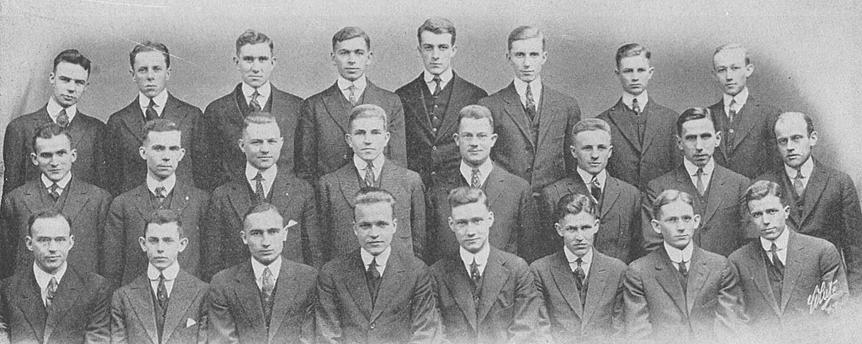
Fifteen members of the chapter came back early in the fall of 1915 and worked hard getting the house in order for the rushing season. The alumni had seen that fresh wallpaper and varnished floors were waiting, so everything looked fine. The result was gratifying: 11 new pledges.
Don Ladd, Earl Marsh, Dick Clary, Bryant Morris, and J. Samuel Barrington ’16 were on the varsity football squad. John L. Bjelke ʼ16 was senior class president, and Herman G. Spencer ’19 was president of the freshman class. Gamma-Xi was proudly displaying the scholarship cup, with every man determined to do his best to keep it.
With the debut of the Denison alumni magazine in 1910, interest in encouraging the graduates to return once each fall for a football weekend evolved, particularly with the efforts of the fraternities to contact their alumni and hold a fall reunion. The first Denison Homecoming was celebrated on November 13, 1915, with a stunning 66-0 win over Akron.
Just when Gamma-Xi Chapter began publishing a periodic newsletter is not known. Letters to the alumni about the chapter’s activities commenced early in the Beta Alpha Delta years, but by 1916, there were some 75 alumni of the chapter. The Gamma-Xi Quarterly was clearly being published then, for highlights of it were reprinted in the March 1916 issue of The Caduceus.
The chapter letter in that Caduceus issue told a perennial story: putting into operation a plan to solve the financial problems of the chapter. It also reported on the many campus activities where the brothers were active.
Gamma-Xi elected Leslie Winans as its Grand Master for 1916-1917 and won the interfraternity basketball championship in 1916. The brothers were also prominent in the class competition. John Bjelke and Jim Gainfort were chosen by the faculty as two of the four commencement speakers.
Don Ladd was elected by the college women as the most popular man and was “Robin Hood” at the May carnival.
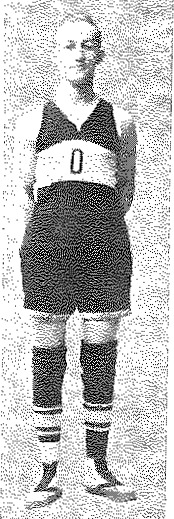
In spring sports, Ralph D. Davies ’18 was a mainstay of the Big Red in the dashes and low hurdles. Don Ladd, Earl Marsh, and Darwin L. Rummel ’18 were on the successful baseball team. Emerald B. Wilson ʼ18 brought varsity tennis to Gamma-Xi’s laurels, as he vanquished a long list of opponents.
As the 1915-1916 school year closed, Gamma-Xi had completed another successful year, and the roll of initiates had reached 104.
That fall, 18 brothers returned to Granville and quickly pledged nine new men. Gamma-Xi had again won the scholarship cup for 1915-1916 by a clear margin. The cup was silver, 18 inches high. The chapter also won the Kappa Sigma District Scholarship Cup for the fifth successive time.
On the Denison football squad, Thomas A. Cook ’19, Dick Clary, Cady Reynolds, and H. Richards Leslie ʼ19 represented Kappa Sigma. Virtually the entire chapter traveled to Dayton to witness the Denison-Miami game. Then everybody journeyed to Middletown and the home of Emerald Wilson where an elaborate dinner was served to 23 undergraduates and four alumni. Cook played every minute of the season, and he and Clary were chosen for positions on a number of the All-Ohio elevens.
Kappa Sigma was represented on the varsity basketball squad by Cook and Wilson, and the March chapter letter reported that much of Denison’s success that season had been due to their excellent work. Wilson led the team in field goals. Gamma-Xi slipped a little in intramural basketball, finishing with a tie for second place.
Ralph Davies was elected Grand Master for the next year. The chapter gave its first annual spring formal dance in late March, and its annual spring party in early May.
The United States had maintained a policy of neutrality from the commencement of World War I in 1914 until 1917. But after threats to the mainland and the sinking of seven U.S. merchant ships that spring, President Woodrow Wilson, who had won reelection by keeping the country out of the war, called for war on Germany, which the Congress declared on April 6. The effects on the Denison campus were immediate. Denison, along with other institutions, offered the use of their facilities for military training. Many of the courses were altered so that the men could receive classroom training in military tactics.
The Denison men voted almost unanimously to adopt compulsory military training and to abandon all forms of spring athletics. Instead, practically every Denison male was spending eight hours a week in military physical training under the direction of Denison’s legendary coach and athletic director, Walter Livingston. Three Kappa Sigmas: Cady Reynolds, Tom Cook, and Dick Leslie, were in the officers’ corps, assisting “Livy” in whipping his “army” into shape. John M. Martin ʼ18, Stanley A. Willer ’19, and Ferdinand H. Dalrymple ’20 left Denison to enroll in military or hospital service. Many other Denison men dropped out similarly. Among those remaining on campus, two military companies were formed. On Memorial Day, these men gave an exhibition drill, later repeated in Newark.
As the school year came to a close, the 1917 Adytum, with Emerald Wilson as editor-in-chief, appeared and was acclaimed by many as the best that had ever been published. “Bubby” was then appointed editor ofThe Denisonian and elected president of the student body for the next school year.
The September 1917 issue of The Caduceus featured Gamma-Xi’s Ladd brothers: Ray, the elder, Don, the middle brother, and Paul ʼ20, the younger, from Bowling Green, Ohio. At the Ladd family home an army service flag was hanging in the front window with four stars upon it for Ray, Don, Paul, and another brother, Jesse, a graduate of West Point Military Academy and a captain in the United States Army. Ray and Paul were corporals in the Ohio National Guard and Don was a lieutenant in the Hawaiian National Guard.
That fall 17 brothers returned to Granville. Eleven did not return because of the draft, to volunteer for service, or to work. In spite of these losses, Gamma-Xi pledged 11 men. The chapter members were involved in every campus activity and were thrilled to learn they had won the interfraternity scholarship cup for the prior year.
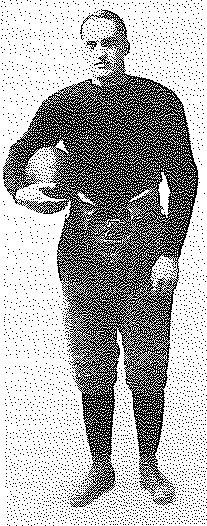
Tom Cook was captain of the Big Red football team, for in spite of the war, intercollegiate football went on as scheduled. In addition to Wilson, the student body president, other class leaders included Charles T. Bumer ’19, junior class president, and Richard R. Barrington ’21, freshman class president.
The Student Army Training Corps was active on many college campuses, including Denison’s. The Selective Service Act of 1917 had provided for it as a means of training officers during World War I. Every man was obliged to take the basic course, and an elective advanced course was offered for upperclassmen. These courses duplicated the training which was given in the Reserve Officers’ Training Corps, not then being offered at Denison.
The national spirit during wartime was reflected by the Denison student body and in the Kappa Sigma house, including elimination of luxuries and even some necessities. Gamma-Xi’s social schedule was curtailed, including the Christmas dance, although a fall party was held with simple decorations—beautiful fall leaves. The chapter steward was working hard to see his brothers enjoyed wholesome meals at as low a cost as possible. Kappa Sigma at Denison proudly displayed its own service flag, bearing 19 stars.
Cook earned a place on the All-Ohio football team by unanimous choice and was soon elected president of the Denison Athletic Association.
Scholarship remained high during the first semester. Only two Kappa Sigmas did not return for the second semester. Military work on campus progressed rapidly with three companies then composing the Denison battalion. By March, the Gamma-Xi service flag bore 26 stars.
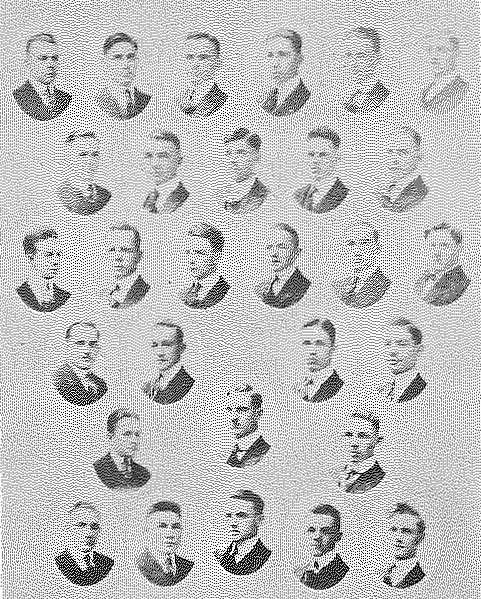
Bubby Wilson, a true campus leader, was chosen captain of the Denison basketball team. He was named to the All-Ohio first team and Tommy Cook to the second. Upon returning from spring vacation, the chapter elected Charlie Bumer as Grand Master for the next year. In the late spring, Cook was named football captain for the second time for the 1918 season, as well as being elected basketball captain for 1919.
In spite of unsettled conditions, it was turning out to be a good year for Kappa Sigma, and spirit remained intact throughout the whole year. One event that was not to be omitted was the annual Mothers’ Day weekend, where the mothers again took over the chapter house. This year the mothers pooled their dollars and presented the chapter with two dozen handsome silver knives. In spring sports, Davies, Schropp, and Leslie B. Tribolet ʼ20 were varsity track men and five of the brothers earned their “D” in baseball.
The next Caduceus chapter letter reported that only eleven brothers returned to Gamma-Xi Chapter in the fall of 1918, but before long they had pledged and initiated nine new men. But it was the loss that fall of 18 men, five from graduation and 13 undergraduates mostly to military service that reduced the chapter numbers significantly. The chapter was pleased to announce that Donald R. Fitch ’22, an initiate of Gamma-Beta Chapter at the University of Chicago, had transferred to Denison and would affiliate with Gamma-Xi.
The Student Army Training Corps was slowly taking shape on campus; drill was held for two hours every morning. Some fraternity houses were being used as women’s dormitories so that their facilities could be taken over by the SATC. The Kappa Sigma house, was used for non-SATC men, of whom five were Kappa Sigmas.
The next chapter letter noted that under a ruling of the War Department, fraternity chapters could hold regular meetings each Sunday in the chapter houses, and did so, including dinner. “As the men of the Denison unit will be given only twelve-hour passes over Thanksgiving, we are planning a dinner and celebration at the house.” While athletics were relegated to a smaller role in the fall of 1918, varsity football went through on schedule.
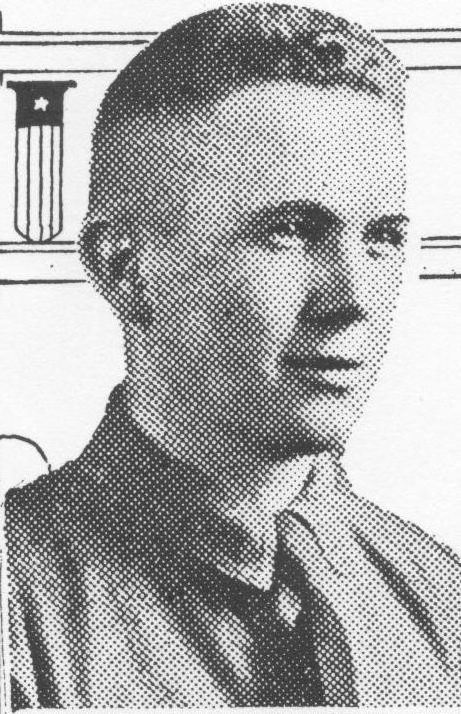 Only one initiate of Gamma-Xi Chapter lost his life during the World War, Paul Ladd. The February 1919 issue of The Caduceus quoted theCleveland Plain Dealer of December 3, 1918: “Attorney J.E. Ladd, prosecuting attorney-elect of Wood County, has been notified this week that his son had been killed in France September 30. Attorney Ladd has five sons, Maj. Jesse, Capt. Dale, Lieuts. Raymond, Donald, and Paul in the service. Paul’s death is the first of the group.” Three of the five Ladd brothers, Ray, Don, and Paul, were Denison Kappa Sigmas.
Only one initiate of Gamma-Xi Chapter lost his life during the World War, Paul Ladd. The February 1919 issue of The Caduceus quoted theCleveland Plain Dealer of December 3, 1918: “Attorney J.E. Ladd, prosecuting attorney-elect of Wood County, has been notified this week that his son had been killed in France September 30. Attorney Ladd has five sons, Maj. Jesse, Capt. Dale, Lieuts. Raymond, Donald, and Paul in the service. Paul’s death is the first of the group.” Three of the five Ladd brothers, Ray, Don, and Paul, were Denison Kappa Sigmas.
The armistice with Germany on November 11, 1918, quickly brought the end of the Student Army Training Corps. After the opening of the second semester, the March chapter letter reported, “The college has again returned to its normal condition, and with it, Gamma-Xi.” Athletics also returned to normal, and Kappa Sigma was represented on the varsity basketball team by three letter men: Tommy Cook, Dick Leslie. and John W. Ehrle ’21. The April chapter letter proclaimed that Denison was second only to Akron for the season. Cook, a three-sport-man and captain of the team, was named captain of the All-Ohio second team.
New officers for 1919-1920 included Herman Spencer as Grand Master. The final chapter letter of the year stated that the tennis team, captained by Stan Willer, lost only one match. Fourteen chapter mothers visited for the annual Mothers’ Day festivity in May. Herman Spencer was elected president of the Denison student government for the next year, and Leslie Tribolet was elected senior representative of the council.
During the year, two more local fraternities became chapters of national orders: Lambda Chi Alpha and Sigma Alpha Epsilon, bringing the number of major fraternities on campus to seven.
The 1919-1920 school year commenced with the return of 23 brothers, who arrived early to put the finishing touches on the remodeling that had occurred during the summer. Eight pledges were the result of rush. Herman Spencer and Thomas F. McMahon ʼ20 were holding regular positions on the varsity football team.
In the fall of 1919, The Caduceus featured a listing of all Kappa Sigmas, by chapter, who had served in World War I. Sixty-seven brothers of Gamma-Xi were listed.
That issue included a special report on Gamma-Xi alumni by its leader, W. Gear Spencer ’07. He wrote that one presumed casualty of the War, Charles E. Warner ’12, who had been reported dead, was later found to be living in Nebraska, to the joy of his brothers. Spencer also announced that another issue of The Gamma-Xi Quarterly would soon be out.
March elections named Gordon D. “Pinky” Hamel ’22 as Grand Master for 1920-1921. A spring 1920, chapter letter reported that as the first semester was concluding, the chapter was composed of 28 initiates and 2 pledges. The next letter said that John Ehrle was distinguishing himself as a guard on the varsity basketball team, and was elected president of the athletic association. Walter A. “Shorty” Reese ’21 was successful in the try-out for cheerleader, “and gives promise of being the ‘peppiest’ man the college ever had for the job.”
The last chapter letter of the school year said the Denison basketball squad finished second to Akron again but only by one-half game in spite of having decisively beaten Akron this year. Denison was led by John Ehrle, who was named to the All-Ohio team. Ehrle was also elected president of the student government, succeeding Spencer.
In its first decade as a Kappa Sigma chapter, Gamma-Xi had proven itself a worthy selection by the Supreme Executive Committee. It had initiated a total of 149 men, including most of the members of Beta Alpha Delta. It had weathered World War I and had acquired a new chapter house on Shepardson Court. The future looked very bright!
